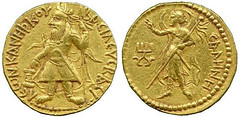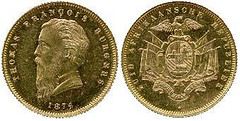
PREV ARTICLE
NEXT ARTICLE
FULL ISSUE
PREV FULL ISSUE
BALDWIN'S AUCTION 91: THE LINDÉN COLLECTIONHarriette Moore of Baldwin's forwarded a
press release about the firm's upcoming auction sale. Thanks.
Here's an excerpt. -Editor
A.H. Baldwin & Sons Ltd, the official sponsors of Coinex 2014, are delighted to be offering the final part of the exquisite Åke Lindén Collection in Baldwin’s Auction 91; World Coins from The Lindén Collection and Other Properties. This staggering collection has dominated both Baldwin’s auction calendar and the wider numismatic market during 2014. With a combined sale total of over $7.5 million to date, the finale sale of Lindén’s coins is sure to see his collection consolidate its place as one of the greatest 19th and early 20th century coin collections in recent years. A spectacular auction for quality and rarity, the sale offers collectors coins from across the globe and history. The auction will be held on 25th September 2014 at The CIPFA conference centre in London, as the official auction of Coinex, the International Coin Fair set in London.
The Selene type is without question the rarest of only four Greek deity types in the gold coinage of Kanishka. It represents Hellenistic influence and is testament to the variety of religious beliefs tolerated across the Kushan Empire during Kanishka’s reign. It is believed that Kanishka himself practised both Buddhism and the Zoroastrian cult of Mithra. This coin presents an extremely desirable companion piece to the Kanishka Helios type, her brother the sun. Extremely fine and of the highest rarity, this coin is believed to be the only example in private hands and is estimated at £25,000-35,000 (US$40,000-60,000) [Lot 3830].
The mint proposed two designs, 695 ‘fine beard’ coins and 142 ‘coarse beard’ pieces. The Legislators objected to Burgers use of his own profile on the coins and rejected both designs. As a result, Burgers Ponds were sold as mementoes, with many being altered and set into jewellery. The successful revival of the Pond in 1892 and the conclusion of the Boer War, ignited numismatic interest in the Burgers Pond, but only a tiny number of these coins remain in mint state. This particular example, with the rarer ‘coarse beard’ design remains in choice mint state with full original lustre and an attractive light tone. One of the finest known examples of this very rare variety, it is estimated to achieve £40,000-60,000 (US$65,000-100,000) [Lot 3395].
To visit the Baldwin's web site, see:
Wayne Homren, Editor The Numismatic Bibliomania Society is a non-profit organization promoting numismatic literature. See our web site at coinbooks.org. To submit items for publication in The E-Sylum, write to the Editor at this address: whomren@gmail.com To subscribe go to: https://my.binhost.com/lists/listinfo/esylum All Rights Reserved. NBS Home Page Contact the NBS webmaster 
|


